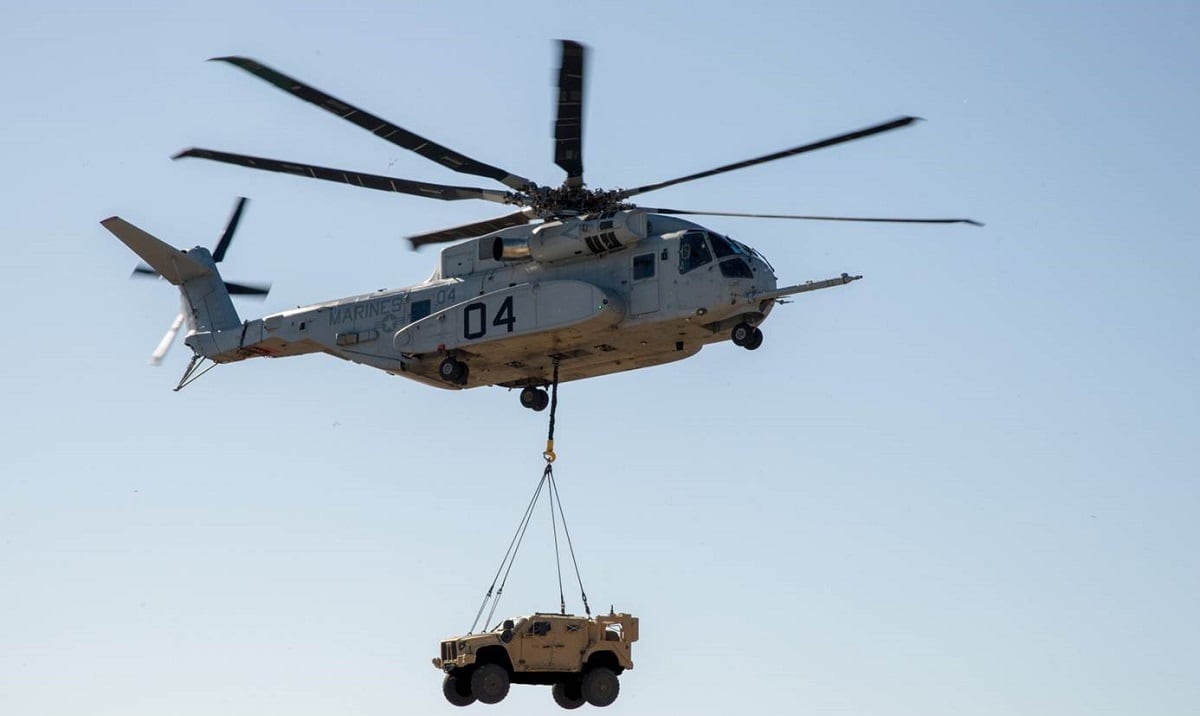The Marine Corps should purchase fewer CH-53K King Stallions while it is still testing the helicopter’s capabilities, a new report from the Government Accountability Office found.
In addition to its recommendation to reduce the low-rate initial production purchases of the Corps’ future heavy lift helicopter, the report raised concerns over the program’s price and Sikorsky’s ability to produce the helicopters at the planned rate.
The helicopter is set to play a crucial part in the Corps’ dispersed operations plan, increasing the service’s ability to transport heavy equipment ― like howitzers and High Mobility Artillery Rocket Systems ― or supplies to a force spread out over the littorals of the Pacific Ocean.
When the Marine Corps received its first CH-53K in 2018 it quickly found more than 100 technical issues that delayed the program by years.
As of late 2020, 118 of the 126 technical problems had been solved, Marine Corps Times reported, but the price tag was high.
When the initial estimate on the program was made in 2005 its lifetime cost estimate was around $708 billion. But more than 100 technical problems and a decision to buy 44 more CH-53Ks than originally planned increased the lifetime cost of the program by 63 percent, the report found.
“As of December 2019, the Navy estimated that the CH-53K would cost about $15.3 billion more to develop and produce and about $29 billion more to operate and support the helicopters through fiscal year 2061 than the estimates first developed at the start of the program,” the report said.
A financial risk?
The decision to buy a total of 200 CH-53Ks was made in 2008 when the Corps planned on increasing the size of the active-duty force from around 174,000 Marines to 202,000.
But the current force design changes proposed by Marine Corps Commandant Gen. David Berger would shrink the Corps back down to about 174,000 Marines and reduce heavy lift squadrons from eight to five.
“This may affect the number of helicopters that are procured,” the report said.
Bill Falk, the director of the CH-53K program for Sikorsky, said the company has no plans to build fewer helicopters.
“The CH-53K program of record remains at 200 aircraft and we are proceeding to deliver those aircraft,” Falk said in an emailed statement to Marine Corps Times on Wednesday.
The report found that the helicopter is at a “moderate” risk of failing to meet the mission reliability and mission payload standards required for the helicopter.
The current CH-53K has a mission reliability probability of 84.5 percent and is expected to reach 88.6 percent by the end of testing.
Both numbers fall short of the more than 89 percent threshold requirement.
Reliability issues can account for up to 70 percent of a program’s lifetime cost, the report said.
The heavy lift helicopter currently meets the mission payload requirement of more than 27,000 pounds, but future updates and redesigns may make the CH-53K gain weight and drop below the threshold.
Sikorsky is currently expected to build 24 CH-53Ks a year for four years during the height of the Corps’ acquisition.
However, the “prime contractor does not fully know the capabilities of its production line and faces issues with its supplier base,” the report found.
The program office still has not inspected the facility expected to produce the CH-53K and design changes that have affected the production line have not been fully accounted for, the report said.
“Further compounding the production problems are the ongoing concerns with the helicopter’s supplier base. The program has faced challenges with poor quality of parts, suppliers not producing enough parts, and process problems, among others,” the GAO report read.
Sikorsky facilities in Connecticut currently have six CH-53Ks on the line while 30 more are in various stages of production, Falk said.
“Sikorsky and its suppliers have made significant investments in facilities, machinery, tooling, and workforce training to ramp up production required for the CH-53K program,” he added.
The initial operational test and evaluation on the aircraft is set to start in June and the Marine Corps expects the helicopter to be ready to deploy by 2023 or 2024.
During that time it is expected to purchase 38 CH-53Ks as part of the low-rate initial production lot ― seven more than it originally planned on purchasing for that lot.
The GAO report said that purchasing weapons systems during the testing process can increase efficiency but comes at the risk of costly retrofits whenever problems are found.
The decision to purchase 38 CH-53Ks during the testing period is seen as too great of a financial risk, according to the report.
“Our prior work has repeatedly found that DoD programs that moved into production carrying manufacturing risks experienced cost growth in production and increases in their average procurement unit costs,” the report said.
The GAO ultimately recommended that the Department of the Navy change its acquisition schedule so that it would only buy 29 CH-53Ks during the testing process.
The Department of Defense disagreed with recommendation, stating that though the schedule may not incorporate all “leading practices,” it was developed in conjunction with industry and government experts is therefore reliable.
“A reduction in planned FY2021 and FY2022 quantities poses greater risk to viability and affordability of the production program than the risk posed by the remaining technical challenges,” a DoD response to the report said.
“The Department does not intend to invest, nor require the Navy or Marine Corps to reprogram funds into development of a new schedule or modifications to the existing schedule construction,” the DoD said.





